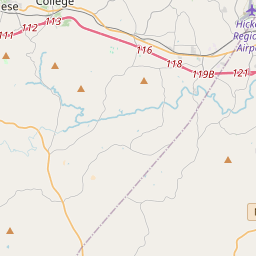Tower of Miracles
Historical marker location:
Hickory, North Carolina
( Marker is on Main Ave. NW..)







© OpenStreetMap contributors
2001
Loading...
Searching for other points of interest within 3 miles of this location.During the Civil War, North Carolina was the second to last state to secede from the Union, doing so on May 20, 1861, and sending more soldiers to fight for the Confederacy than any other state.
About Catawba County
Catawba County Timeline
Catawba County, located in North Carolina, has a rich history that dates back thousands of years. The area was home to indigenous peoples, including the Catawba and Cherokee tribes, who thrived along the banks of the Catawba River. Europeans first settled in the region in the 18th century, with the establishment of Fort Dobbs in 1756 to protect against Native American attacks.
During the early 19th century, Catawba County developed into a bustling center for trade and commerce, thanks to its strategic location along major transportation routes. The arrival of the railroad in the 1850s further accelerated growth, connecting Catawba County to larger markets and leading to the establishment of new towns and industries.
The county played a significant role in the Civil War, with many of its citizens enlisting in the Confederate Army. Catawba County faced hardships during the war, including economic struggles and the destruction caused by Union forces. However, the area slowly recovered in the post-war years, focusing on agriculture, textiles, and furniture manufacturing as its primary industries.
In the 20th century, Catawba County experienced continued growth and industrialization. The county became known as the "Furniture Capital of the South," with numerous furniture manufacturers establishing operations in the area. Over time, the economy diversified, and Catawba County now boasts a thriving manufacturing sector, including industries such as automotive, technology, and healthcare.
Today, Catawba County remains an important center of economic activity in North Carolina, with its rich history contributing to its cultural vibrancy. The county preserve its past through historical sites, museums, and festivals that celebrate its heritage and the contributions of its diverse communities.
During the early 19th century, Catawba County developed into a bustling center for trade and commerce, thanks to its strategic location along major transportation routes. The arrival of the railroad in the 1850s further accelerated growth, connecting Catawba County to larger markets and leading to the establishment of new towns and industries.
The county played a significant role in the Civil War, with many of its citizens enlisting in the Confederate Army. Catawba County faced hardships during the war, including economic struggles and the destruction caused by Union forces. However, the area slowly recovered in the post-war years, focusing on agriculture, textiles, and furniture manufacturing as its primary industries.
In the 20th century, Catawba County experienced continued growth and industrialization. The county became known as the "Furniture Capital of the South," with numerous furniture manufacturers establishing operations in the area. Over time, the economy diversified, and Catawba County now boasts a thriving manufacturing sector, including industries such as automotive, technology, and healthcare.
Today, Catawba County remains an important center of economic activity in North Carolina, with its rich history contributing to its cultural vibrancy. The county preserve its past through historical sites, museums, and festivals that celebrate its heritage and the contributions of its diverse communities.
Catawba County Timeline
This timeline provides a concise overview of the key events in the history of Catawba County, North Carolina.
- 1747: Catawba County is established as part of Anson County.
- 1792: The county becomes part of Lincoln County.
- 1842: Catawba County is officially formed as a separate county.
- 1870s: Catawba County experiences significant growth with the arrival of the railroad.
- 1920s: Catawba County becomes a hub for furniture manufacturing.
- 1940s-1950s: Catawba County's economy diversifies with the growth of textile industries.
- 1980s: Catawba County faces economic challenges with the decline in the textile and furniture industries.
- Present: Catawba County continues to focus on economic redevelopment and diversification.